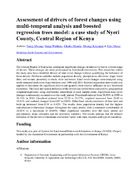| dc.description.abstract | The Central Region of Kenya has undergone significant changes in land cover due to a broad range of drivers. These changes are more pronounced in forestland conversions. Past researches within the study area have identified drivers of land cover change without quantifying the influence of these drivers. Predictor variables include population density, precipitation, elevation, slope, forest fires, soil texture, proximity to roads, rives and towns. Land cover changes were analyzed using multi-temporal land cover maps between year 1990 and 2014. Boosted regression trees model was applied to determine the significant drivers and quantify their relative influence on key forestland transitions. The local and spatial influence of the drivers has further been analyzed by geographical weighted regression using coefficients determined at each sample point. Significant land cover changes continuously occurred over the study period. Forestland reduced from 38.90% in 1990 to 38.14% in 2014. Grassland reduced from 32.59 to 22.57%, cropland increased from 28.05 to 38.83% and wetland changed from 0.07 to 0.04%. Other land which constitutes of bare land and built up increased from 0.38 to 0.42%. The results show population density had the highest contribution to forestland changes throughout the study period, with a minimum contribution of 20.02% to a maximum of 26.04%. Other significant variables over the study period are precipitation, slope, elevation and the proximity variables. The results indicate that the relative influence of the drivers to forestland conversion varies with time, location and type of transition. | en_US |
